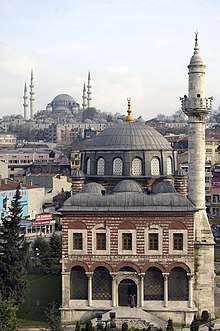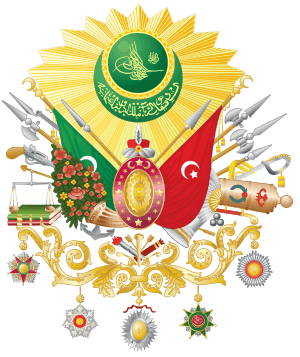Şebsefa Kadın
Şebsefa Kadın (Ottoman Turkish: شب صفا قادین; c. 1766[2] – c. 1805) was the eighth wife of Sultan Abdul Hamid I of the Ottoman Empire.
| Şebsefa Kadın | |||||
|---|---|---|---|---|---|
| Born | c. 1766 | ||||
| Died | c. 1805 (aged 38–39) Constantinople, Ottoman Empire (modern-day Istanbul, Turkey) | ||||
| Burial | Şebsefa Kadın Mosque, Istanbul | ||||
| Spouse | Abdul Hamid I | ||||
| Issue Among others | |||||
| |||||
| House | Ottoman (by marriage) | ||||
| Religion | Sunni Islam | ||||
As imperial consort
Şebsefa Kadın married Abdul Hamid, and was given the title of "Sixth Consort".[3] On 20 September 1782, she gave birth to her first child, a son, Şehzade Sultan Mehmed Nusret, who died at the age of three on 23 October 1785.[4]
Two years later on 11 October 1784, she gave birth to her second child, a daughter, Alemşah Sultan, who died at the age of one, on 10 March 1786.[4][5] Three years later on 4 February 1788, she gave birth to her third child, a daughter, Emine Sultan,[6] who died at the age of about three on 9 March 1791.[7][8]
In 1788, Şebsefa became pregnant with her fourth child. In January 1789,[9] Captain David G. Sutherland noted following about her:
...he has attached himself to one. His happy favorite is now pregnant for the fourth time, and such is the attention paid her, that the vessels in the harbour are obliged to suspend the regular method of carrying on duty, and are not permitted to fire a musket, nor to strike the bell, nor even to give the word of command in a loud voice.[10]
On 16 March 1789, she gave birth to a daughter, Hibetullah Sultan.[11][6] She was widowed after Abdul Hamid's death a month later, after which she settled in the Old Palace.[12]
Properties
In 1798, Şebsefa acquired the Depecik çiftlık of Cihanzade Hüseyin Bey in Aydın Güzelhisar for 33,500 kuruş, and also owned agricultural land in the vicinity of Salonica, apart from a pension out of the funds of the Istanbul customs.[13][14] After her death, all the çiftlıks were assigned to her daughter Hibetullah Sultan.[15][12]
Charities
Şebsefa is noted for the foundation bearing her name in the Istanbul area of Zeyrek, established in 1787 according to the inscription over the entrance to the mosque. Originally built on different levels, the foundation consists of mosque, primary school and fountain, along with the grave of the foundress. An endowment, dated 1805, specifies that the school was also to be open to girls, a provision which has earned Şebsefa the reputation of a pioneer in Ottoman female education.[14][12][16] She contrived the mosque in the memory of her son Şehzade Mehmed Nusret who died as a child.[17]
Death
Şebsefa Kadın died in 1805, and was buried in her own mosque located in Zeyrek, Istanbul.[15][1]
Issue
Together with Abdul Hamid, Şebsefa had four children:
- Şehzade Sultan Mehmed Nusret (20 September 1782 – 23 October 1785, buried in Tomb of Abdul Hamid I);[4]
- Alemşah Sultan (11 October 1784 – 10 March 1786, buried in Tomb of Abdul Hamid I);[4][18][5]
- Emine Sultan (4 February 1788 – 9 March 1791, buried in Tomb of Abdul Hamid I);[4][7][8]
- Hibetullah Sultan (16 March 1789 – 18 September 1841, buried in Tomb of Mahmud II), married 3 February 1804, Damat Alaeddin Pasha (died at Scutari, January 1813), son of Damat Seyid Ahmed Pasha;[11][19]
Gallery
 Şebsefa Kadın Complex
Şebsefa Kadın Complex
References
- Sakaoğlu 2008, p. 498.
- Sarıcaoğlu 1997, p. 8.
- Uluçay 2011, p. 163.
- Sarıcaoğlu 1997, p. 13.
- Sakaoğlu 2008, p. 511.
- Sarıcaoğlu 1997, p. 14.
- Uluçay 2011, p. 171.
- Sakaoğlu 2008, p. 512.
- Sarıcaoğlu 1997, p. 10.
- Sutherland, David G. (1790). A Tour Up the Straits, from Gibraltar to Constantinople: With the Leading Events in the Present War Between the Austrians, Russians, and Turks, to the Commencement of the Year 1789. p. 358.
- Uluçay 2011, p. 170.
- Sakaoğlu 2008, p. 499.
- Uluçay 2011, p. 163-64.
- Bosworth, Clifford Edmund (1997). The Encyclopaedia of Islam, Volume 9. Brill. p. 412. ISBN 978-9-004-10422-8.
- Uluçay 2011, p. 164.
- "ŞEBSAFÂ KADIN KÜLLİYESİ İstanbul'da XVIII. yüzyıl sonlarında inşa edilen külliye". İslam Ansiklopedisi. Retrieved 9 February 2020.
- "Vefa Sebsefa Hatun Camii". turanikinci.com. Retrieved 1 July 2020.
- Uluçay 2011, p. 169.
- Sakaoğlu 2008, p. 507.
Sources
- Uluçay, M. Çağatay (2011). Padişahların kadınları ve kızları. Ötüken. ISBN 978-9-754-37840-5.
- Sakaoğlu, Necdet (2008). Bu Mülkün Kadın Sultanları: Vâlide Sultanlar, Hâtunlar, Hasekiler, Kandınefendiler, Sultanefendiler. Oğlak Yayıncılık. ISBN 978-6-051-71079-2.
- Sarıcaoğlu, Fikret (1997). Hatt-ı Humayunlarına göre Bir Padişah'ın Portresi: Sultan I. Abdülhamid (1774-1789).
